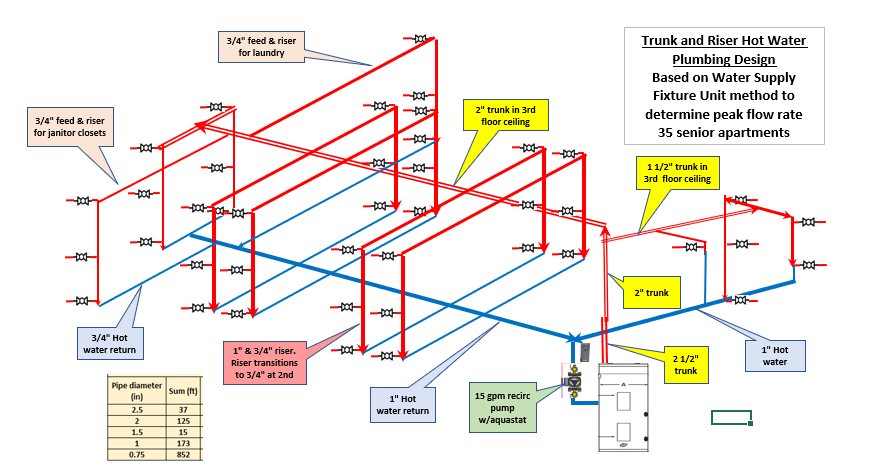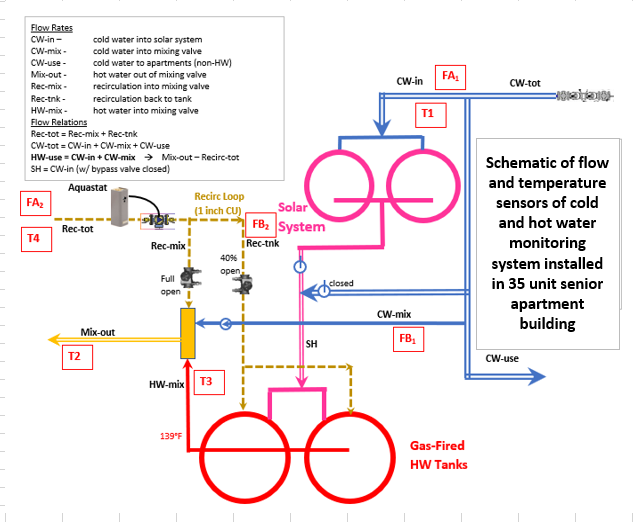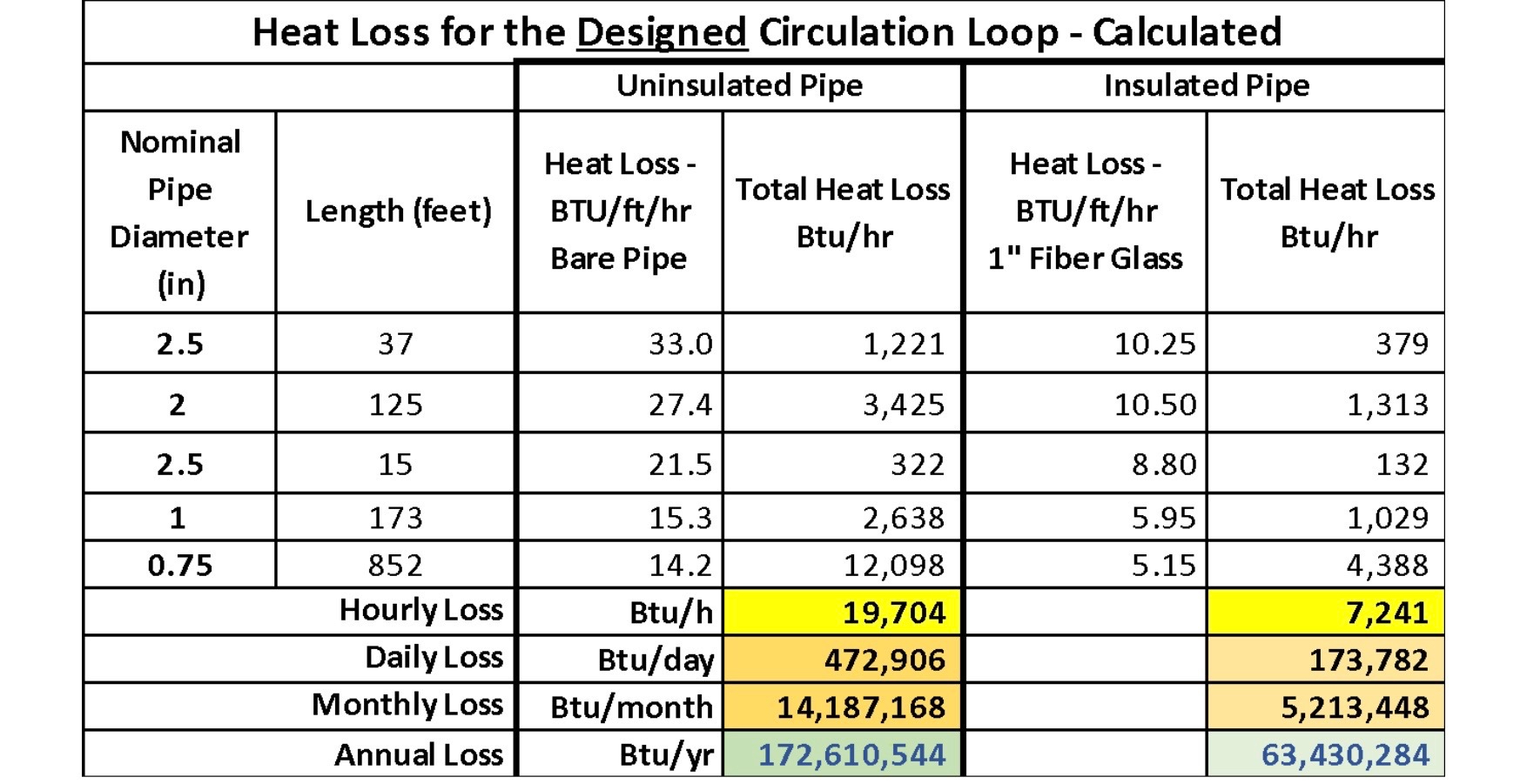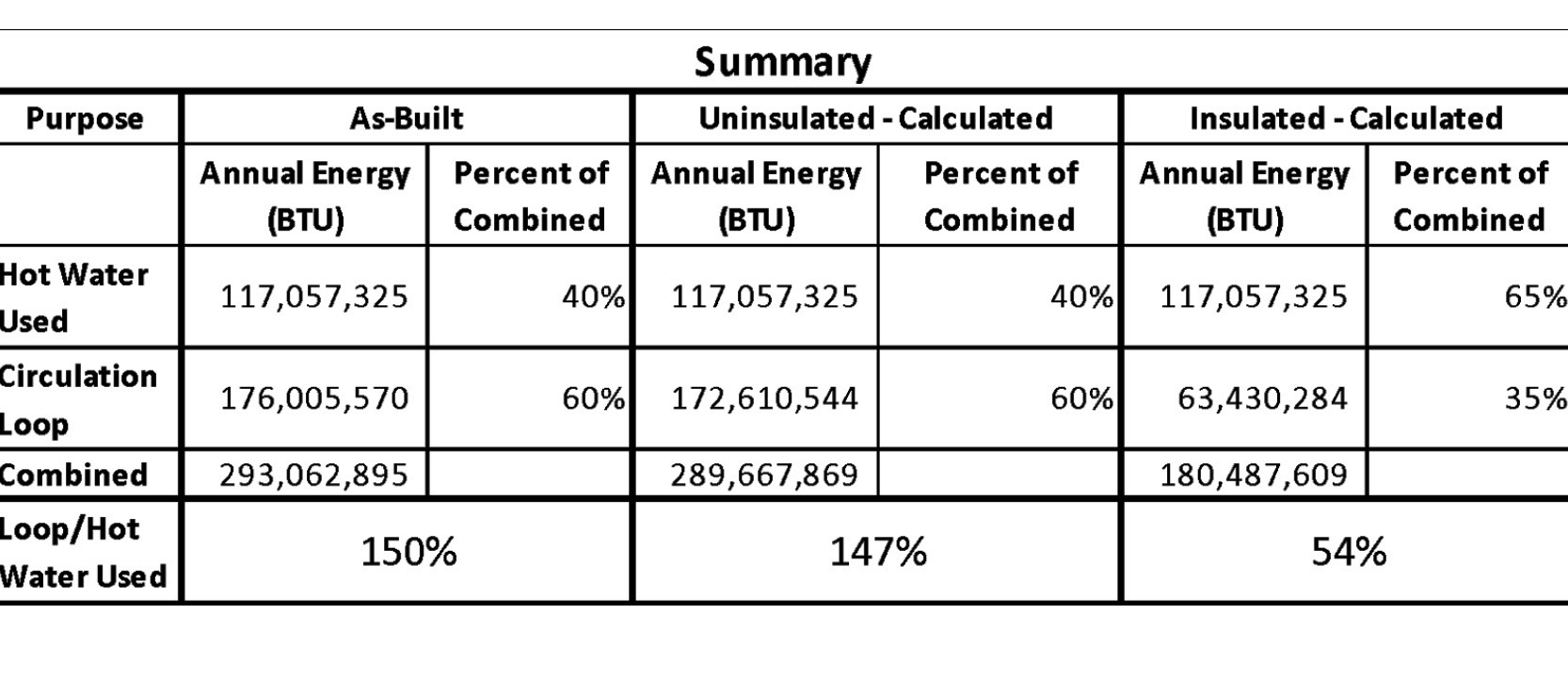Hello again. Gary and I covered a lot of ground in our last article in this magazine. That one focused on the tensions between achievement of fast delivery of hot water and the price paid in terms of pressure loss in smaller tubing that makes it all happen. It also focused on making the tenants happy with fast delivered hot water and the world happier because of minimized water and energy waste.
Now plumbers and engineers, let’s please consider some of the energy ramifications of hot pipes inside our buildings. Face it, be it PEX, CPVC, copper or any other piping material, long pipes with hot water inside are radiant heaters. Yeah, in the winter, in some climates, these pipes help heat the building. But in the warmer months, and these are increasing in all climates, these long pipes, also known as radiators, give off heat that must be removed in today’s tight buildings with HVAC systems. This results in electricity or fossil fuels getting used to create hot water. Some of which gets consumed and some of which is dissipated as heat on the way to being used. The waste heat from which must be captured and dumped back outdoors – with yet more energy. Our clients lose both ways.
And, excessive recirculation exacerbates this problem, especially if the pipes are not fully insulated. We have an amazing example for you. One that is unfolding even as we write this article. Read on. We have quite a story to tell.
Pipe heat loss phenomena
Hot pipes in cooler spaces cool down over time. The losses from the piping need to be included as part of the cost of heating the water used in the building.
ASHRAE has a method to calculate the heat loss rate expressed as Btus/hour/lineal foot. References like Uponor’s Plumbing Design Assistance Manual (PDAM) provide matrices of values for different PEX pipe sizes at different temperature differences between water temperatures inside and air temperatures outside for a range of diameters of bare pipe and insulated pipe.
Here’s an example. Let’s say we designed, and the plumber installed, a 1” PEX tubing 200 foot long hot water circulation loop without insulation in a client’s house. The house has 130 degree water flowing inside the pipes with continuous recirculation and the building is at 70 degrees. That’s a delta T of 60 degrees. Uponor’s table, on page 171 of the manual, shows that the heat loss rate for that bare pipe would be 16.6 Btu/hr/ foot but for pipe insulated with 1” fiberglass it would only be 6.5 Btu/hr/foot. Let’s do the math to determine the heat loss associated with the uninsulated loop: 16.6 Btu/hr/foot times 200 feet = 3,320 Btu/hr times 8760 hours per year comes to 29,083,200 Btus/year lost. It would be about 33 percent worse if this bare PEX loop was in a 50 degree basement.
Let’s assume that we hung the PEX loop in conditioned space and our client heats her hot water with electricity with a 95 percent efficiency. She will be spending 8,972 kWhrs annually because we didn’t insulate her PEX loop. Again, let’s assume she lives alone and uses 20 gallons of hot water per day and the annual average cold water temperature is 55 degrees. Our client would use 1,409 kWhr to heat the hot water she uses over the year. This means the loop losses are almost 6.4 times larger than the actual useThis is a big price to pay annually. Yes, the heat lost from the pipe in the winter helped keep her house warm. But in the summer, she will have to pay even more money to run the HVAC system to dump the wasted heat outside. If the loop was in an unconditioned basement, the heat lost by the loop would not do her house energy budget any good.
Heat waste is writ large in multifamily buildings
Let’s look at what happens when our client is a 35 unit new multifamily building. The mechanical specifications call for a hot water trunk, riser and branch design. The pipes were sized using the International Code Council’s water supply fixture unit approach which resulted in a peak flow of 50 gpm even taking advantage of the savings due to bathroom groups. By the way, in a similar building with senior occupancy, we only measured on-site a 2.34 gpm maximum at the 99.9% level.
An isometric of the design appears below. A large pipe conducts hot water to the ceiling of the third floor and risers conduct water downward, though the 14 risers to the mechanical closets of the individual apartments. The simple (as opposed to a reverse) return collects the water at the end of the risers in the first floor ceiling and brings it back to the main mechanical room. According to the project documents, the piping was to be insulated with 1 inch fiberglass pipe insulation.

Verifying the performance of the design
Our collaborator, Hugh Henderson, set up a state-of-the-art, one-minute data measurement system at a similar building that measures the flow rate and temperature of the hot water flowing out of the thermostatic mixing valve and returning through the recirculation pump for reheating. It also measures the incoming cold water temperature and flow rate.
These numbers allow us to calculate the energy it takes to heat the water used by the tenants as well as the energy needed to keep the loop hot. Figure 1 shows the schematic of the instrumentation layout. There are four flow rate and temperature sensors that feed their information into the data logger which transfers it to the cloud from which we download the data and analyze it. Figure 2 shows Hugh Henderson, adjusting the settings in the onsite data capture box.

Table 1 shows that the circulation pump was moving water at about 6.7 gpm. The temperature drop around the loop was 6F. The calculations show that the heat loss is about 20,000 Btu/hr and the annual loss more than 176 million BTU.

These losses seemed large and got us wondering how these losses compared to calculated heat loss and to actual hot water use. Recent measurements have confirmed this troubling heat loss pattern.
Table 2 presents the energy needed to heat the hot water used by the tenants. The average hot water use per apartment is 15.7 gallons per day. The energy to heat this water is 9,163 Btus per day per apartment.

Let’s compare the energy used to the energy lost in the loop. The loop losses are 482,207 Btu per day. The hot water energy is 320,705 Btu per day. Okay, we knew loop losses were often a large portion of the daily energy use, but these losses are larger than the use by 50 percent. This got us wondering how the measured losses compared to calculated heat losses.
Table 3 presents the calculated heat losses for the designed hot water circulation loop. As before, we used Uponor’s manual as the source for the heat loss per foot numbers. We calculated the heat loss for each diameter and length of pipe and summed these up to get the hourly totals. We then extended the numbers to get daily, monthly and annual totals.

Wait a minute. The measured loop losses are remarkably close to the calculated values for uninsulated pipe! If the pipe had been well-insulated, losses would be only 37 percent as large.
Table 4 provides a summary of this analysis. Any way you look at it, the as-built loop losses are large; much larger than the energy used by the tenants; either 60 percent of the daily energy use or 150 percent of the hot water used. The calculated losses demonstrate that the loop is acting as though it is uninsulated. Not a good sign! The calculated values show that a properly insulated loop would require less energy than the uses. While still large, this would be much better than what we found.

Insulating hot pipes is critical
Insulating pipes and fittings is something of an art form, best practiced by pipe laggers who do this work all day. Plumbers strive diligently to make their piping leak free – at least for fluids. Energy losses are leaks too but sadly, are invisible. This article should be taken to heart. Uninsulated or poorly insulated pipes can create huge leaks of energy. Think about it when the job appears done when the water is flowing nicely without leaks.




